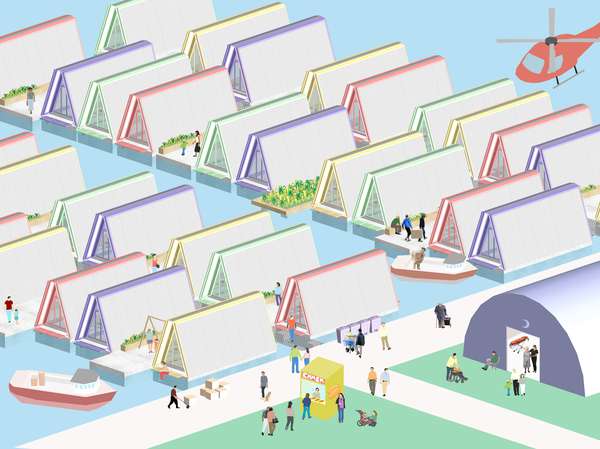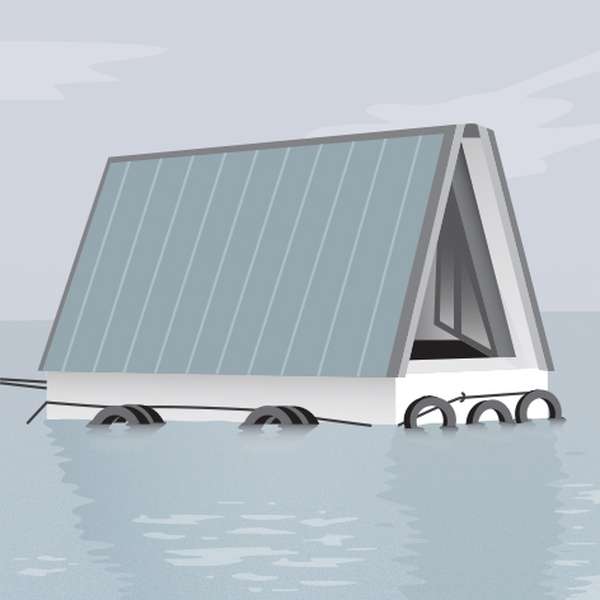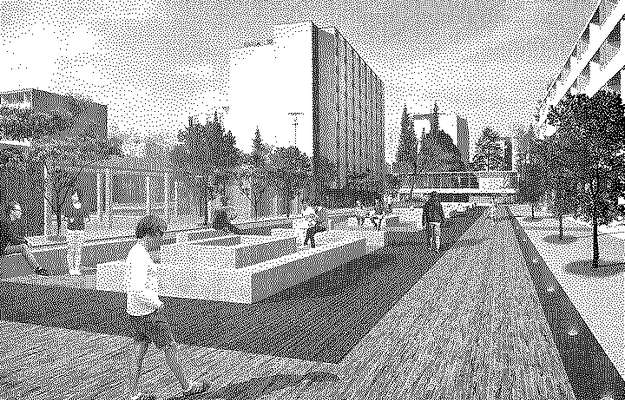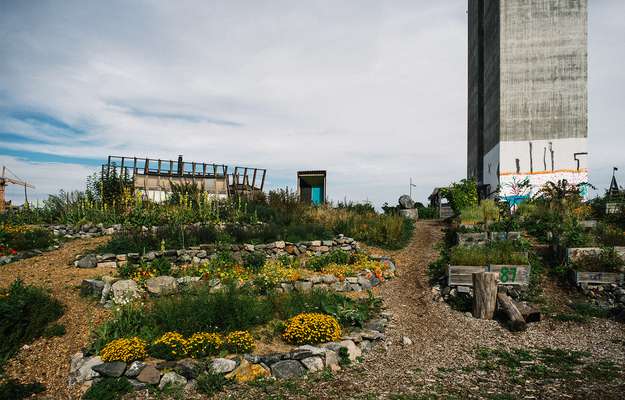Unsunk Heroes. Hope on Water
Excerpt from the chapter ‘Unsunk Heroes’ Inspired in the project ‘Hope on Water’ by Sevince Bayrak, Oral Göktaş. The text is featured in the forthcoming book ‘Fables and Constructions’ by Lucie Kohoutová & Martina Freitagová. This is the title of the winning entry for the FINAL_FINAL writing grant launched by dpr-barcelona within the Future Architecture 2019 Call for Ideas.

The Beauty of a Gesture
They call this Fold and Float; and when you say Fold, there’s no way you can shun us, the Hinges.
We’re the spirit and soul of this space, we like to think. Allowing for its very existence, reliably connecting its parts.
There’s oh so many of us: running along the roof’s ridge, holding the side doors, making all the different pieces of furniture pop up or disappear in a split second. Even if you —like most people— tremble at the mere thought of assembling a new IKEA piece for your home, we’ve got you covered: just open and fold, open and fold, and your closet, kitchen top, or sitting area are ready. Not just the furniture; your whole shelter for the upcoming year —assembled in no time, requiring no skill.
Our pins and leafs and knuckles make things easy, changeable, foldable. We have the one degree of freedom —which is probably still more than most people here have, being left with nowhere else to go after the earthquake took their homes. Spring hinges, H hinges, strap hinges: we made it possible to offer them shelter, ready and easy to use.
Maybe it looks all technical and hardware store catalogue to you, but give it a second thought: being a hinge —at least from where we’re floating— is actually about grace, flow and suppleness. La beauté du geste, as the famously theatrical Parisian chef Alain Passard would say. And we’re no less sure of our skills than he is.
Floating on the waters of the Golden Horn, we enjoy the sun and the soft sound of the waves, the perfect soundtrack for our calm yet determined vinyāsa. Look closer and enjoy every phase of these recurrent gestures, just like we do: there’s the opening of the doors on both sides in the morning, our sun salutation. First the A one with just the doors, one, two, change side, three and four. Continue greeting the sun with the B: the whole side wall opens and stretches up, almost blending into the roof panels above. Inhale, exhale, fresh air flows through the entire structure; inhale, exhale, let’s welcome every ray of light that enters the frame, letting the shelter’s inhabitants relish it as well.
Then we get to planks, both literally and figuratively: we lower boards and support them, if place for more sleepers is needed; shall they be lucky enough to move somewhere else, after long months of waiting in the shelter, we push back up to downward-facing dog and relax, waiting for more dwellers to join.
They call this Fold and Float, but, as you see, it’s all the unfolding that we’re actually here for. So when the time finally comes to wrap the main roof hinge, the final pose is a bittersweet moment: the joy of knowing that our dwellers are finally getting a true roof over their heads after long months of crouching under ours mingles with the calm sadness of the śavāsana. Immobile, carried, and stored away, we lay devoid of life.
Until, possibly, likely, the wait for our next practice is over: not that we wish for any kind of disaster, but should they call on us, we’ll happily unfold and float once again, all strong and balancing nature’s forces. In our favorite pose, the navasana.

The Beauty of a Brushstroke
“The sun never knew how wonderful it was, until it fell on the wall of a building”. Although not exactly a building, I recall Louis Kahn’s thought every time a ray of light caresses my sleek, light grey metal surface. I’m just a roof, not the centre of the solar system, but I sure do feel wonderful, stretching proud and large in my colourful steel frame, ready for its rays to fall. I am a canvas impatiently waiting for the first stroke of the master’s brush. In spring, the contemplative calligrapher conducts his qalam in light-headed naskh cursive at first, barely touching the panels with its round, horizontal, feathery lines. Then, as the sun’s rays start to gain length and vigour, the calligrapher’s strokes turn to the broader and more sweeping nasta’liq style, as if laid down by the venerable Persian master Mir Emad Hassani himself, their generous rods sloped on my surface in almost the same angle as I form with the shelter’s concrete floor. With warm days approaching, the sun beats down harder and harder, filling me with square, dense, strict kufic; at the height of summer, I feel like a medieval mausoleum covered with banna’i, just using sun rays instead of decorative tiles and the sun’s own secret language instead of religious words. The Prophet said that the first thing God created was the pen, but what if He actually started with a sunbeam, revelling in its touch, creating both life and words at the same time?
As I muse on the sophisticated curves and corners of Islamic theology and calligraphy, the community kids come at night and replace the elegant, ethereal sun strokes with their own felt-tips and spray paint. Ugly or marvellous, simple tags or ornate ‘calligraffiti’, tiny quick panda eyes or an elaborate full-size mural —although I’m never asked about all this, I certainly understand their need to enliven the tent-like regularity of their temporary dwelling. Also, no matter the quality, the autumn rains always come to test the colours’ stamina. There are the occasional storms, whipping hard and strong at the sturdy sandwich panels, making the elders underneath pray while their children turn their music up to drown out the thudding rain. There are rains that I barely notice; if their drops were any smaller, they would just vaporize into a gentle mist; and then there are the soft, long downpours that I like the most, their billions of droplets tap upon me like playful, slightly impatient fingers. Their rhythm lulls me and the people I shield from this downpour to sleep as they lie below on their backs, staring up into the dark and, hopefully, feeling grateful for my presence above their heads.
In the winter, the snow comes: its first flakes land gently on me and vanish before I have the time to admire their filigree symmetry. Then, as they become more and more numerous, a thin cold veil forms on my surface, making me all sugar-coated and sparkling in the chilly winter sun, like the surface of the water I float on. Until they become too thick and slide down my steep slope in one brusque resolute movement, leaving me bare again, ready to take on any whim of the weather or the humans I house.
The Beauty of a Cast
I am a star: veneered in art museums, fetishised in coffee-table books, hashtagged on Instagram posts. I am a villain: denounced by tenants, politicians, and the Guardian alike. That’s OK though, I’m used to both praise and disdain. You can call me three-dimensional poetry or moulded elephant dung, I’ll still be the number one construction material in the world, because I’m malleable, cheap, versatile.
There are so many things you can be when you’re concrete: an impossibly ugly Pinterest garden statue (looking at you, campy toadstool lovers) as well as the awe-inspiring largest non-reinforced concrete dome in the world, still standing over the Roman Pantheon nineteen centuries after its construction. Peter Zumthor’s rustic fire-fighter and Le Corbusier’s ethereal white steamship. A curvy designer lamp post a yuppie has just milked his credit card for and the mundane square tile he walks on to work every day without a second thought. A Maginot Line shelter and a family house in Tokyo (only slight changes in design needed).
I’m like an actor: I need to be cast.
In the right hands, I turn to gold. Hard, rough, the colour of beach sand on a chilly winter morning, but still gold. Temples and tombs, domes and dams —just flick through one of the many concrete porn books out now and you’ll know what I’m talking about.
Don’t get me wrong - I’m well aware of my ecological drawbacks. I’m far from denying that both my production and extensive use at the expense of more natural solutions is a highly unfortunate direction to follow, or that I account for nearly a fifth of the world’s landfill waste. I’m the first to agree that I should be used with more deliberation and humility. Even for my vain side: I obviously prefer to be the beautiful swan of the Sydney Opera House (or the stark vulture of the AT&T Long Lines Building) than the ugly ducklings that are malls, spaghetti junctions, parking lots, and the general urban sprawl devoid of scale and taste.
Because, I’m just like most of you folks: I like to feel pretty and useful.
Which makes me quite fond of my recent Turkish incarnation —what a pleasant surprise! Being cast into a vessel isn’t unheard of —courtesy of World War I & II steel shortages— and I’m used to pontoon-floating among yachts and other ships. Yet, to become the base for a whole network of emergency shelters, that’s… responsible, I guess. Here, people really lean on me, in all sorts of ways. I’m not playing important —it’s just a matter of fact. With the original evacuation terrains being turned into parking lots and residential developments way before the earthquake, the waters of the Golden Horn seemed to be one of their rare hopes, unaffected by tsunamis and bearing strategic seaway access. Shaped by a forward-thinking Istanbul architectural practice that pursued solutions instead of disastrous scenarios, I became this thick block of hybrid concrete, designed especially to absorb the movement of the water it sits on. A new home for up to six people.
Our relationship may last six months, a year, or even two; it’s not a life-long commitment. However long the liaison, I’ll support my dwellers both literally and figuratively. Cool down their cheeks in the scorching Istanbul summer. Soak up their tears when their loved ones stop being missing and start being dead. Pray with their elders and play with their kids. Keep them afloat.


